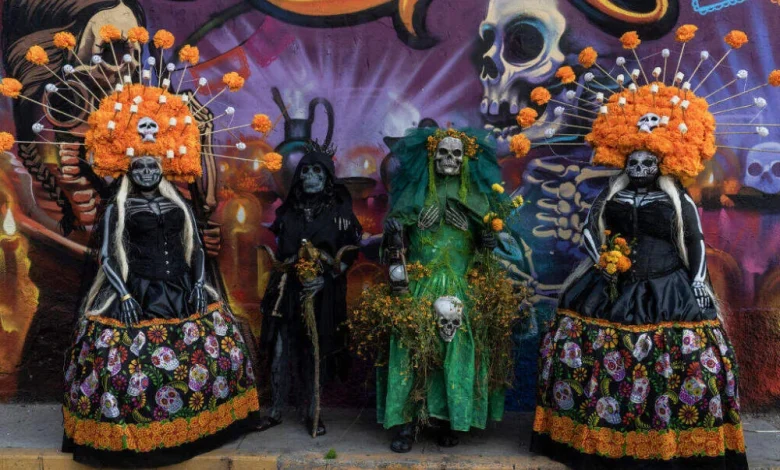Death is the boundary that gives love its shape

Being Mexican means sensing life and death as different currents of the same breath. Even as a child, I didn’t imagine death as a skeleton with a cape lurking in the corner. To me, it’s always felt strangely calming to see life as a circle, not a line.
Every fall, we build altars for loved ones who have passed. Intricate tiers of their photos and favorite foods are threaded with cempasúchil — bright orange marigolds whose scent is said to guide souls home on the Day of the Dead. Rooted in Indigenous traditions, this ritual carries an entire cosmovision that honors the cyclical nature of life and death.
Apparently, holding that boundary wasn’t enough for me this year. I had to reach for the edge between the physical and the digital worlds, too.
A few days before Day of the Dead, I found myself surrounded by orange marigolds and dim candles watching “Her.” Set in the “future” of 2025, the film follows a man who falls in love with an AI designed to learn from him and become whatever he needs. In one scene, the AI resurrects the philosopher Alan Watts, pieced together from his books and recordings.
Somewhere between the algorithm and the altar, my mind drifted to the one soul I return to every Day of the Dead: my aunt, the matriarch of my father’s family. She was a commanding presence with a voice of velvet and thunder. In her home in Monterrey, in northern Mexico, her kitchen smelled of cloves and warmth as she cooked for days to feed her eight siblings and their families. A devout Catholic, she wasn’t part of the choir — she was the chorus. But her greatest power was invisible: a force that held a large, unruly family together.
Elementary school children, parents and people from the community, begin a procession through Chicago’s Pilsen /Little Village neighborhood celebrate the tradition of Dia de los Muertos on November 1, 2001. Charles Bennett/AP)
Ever since she passed away in the spring of 2018, this season has belonged to her. Some years, I build an altar; others, I settle for a few flowers, a traditional recipe or a story about her over dinner. These rituals make me feel a little more whole and closer to her, regardless of where I am in the world.
Last year around this time, I felt stuck in the in-between while waiting for immigration papers. One evening, I made flour tortillas from scratch in my apartment in Allston. My kitchen couldn’t have felt farther from the home where I grew up. Then, with the faint burn of the pan, came the scent of my aunt’s cooking. And, as always, her presence arrived as wisdom in words she never spoke: We braid our roots with our future as we go.
Watching “Her,” it was inevitable to wonder what it would mean to keep endlessly braiding with my aunt. We already live in a time when AI tools can stitch her voice, memories and likeness into digital form such that I could seek her advice as I grow into the role she once had, to hold our family together. There is so much room for wonder in technology. Yet, my Mexican roots bristle at the idea of using it to escape grief.
Death is not an error to debug — it’s the boundary that gives love its shape.
We’ve always sought ways to remember our loved ones in photos, videos, letters and recipes. But AI models are different: They promise conversation without end. Systems built to predict, to extend us beyond our mortality, to simulate presence so perfectly that grief starts to feel like an avoidable inconvenience.
The way we design and use these models reveals how we’ve come to understand love itself — through inputs and outputs, through the tallying of gestures and words. It’s no surprise so many teenagers are turning to AI companions to soothe loneliness with endless validation, flawless memory, constant attention.
Of course, we reach for the algorithm. In the abyss of loss, an AI-generated response feels like safety. But while the algorithm resists the mystery through prediction, the altar surrenders to it.
Because the truth is that so much of love is death. Bodies age, memories fade. Death is not an error to debug — it’s the boundary that gives love its shape. That’s why radical love is radically finite.
What many misunderstand about Día de los Muertos is that it isn’t a celebration of death, nor a denial of how much it hurts. It’s a way to make space for grief — for the ache and joy that cohabit in remembrance. My aunt’s absence makes me miss her, and it is because I miss her that I can still feel her presence.
We can’t hack our way through grief. It’s meant to be lived, carried through our choices and our rituals. I could archive my aunt’s photos and her letters. One day, my children might even be able to speak with her as an actual hologram. But it’s me who must embody her force — to carry her forward within my own limits. To step into my voice, even if it trembles. To bring my family together, even from far away. To hold her traditions and create new ones for the generations to come.
That, to me, is the spirit of Day of the Dead: breathing in paradox, letting mystery move through us and exhaling love. To embrace that not everything should be understood. Some things are simply meant to be felt.





